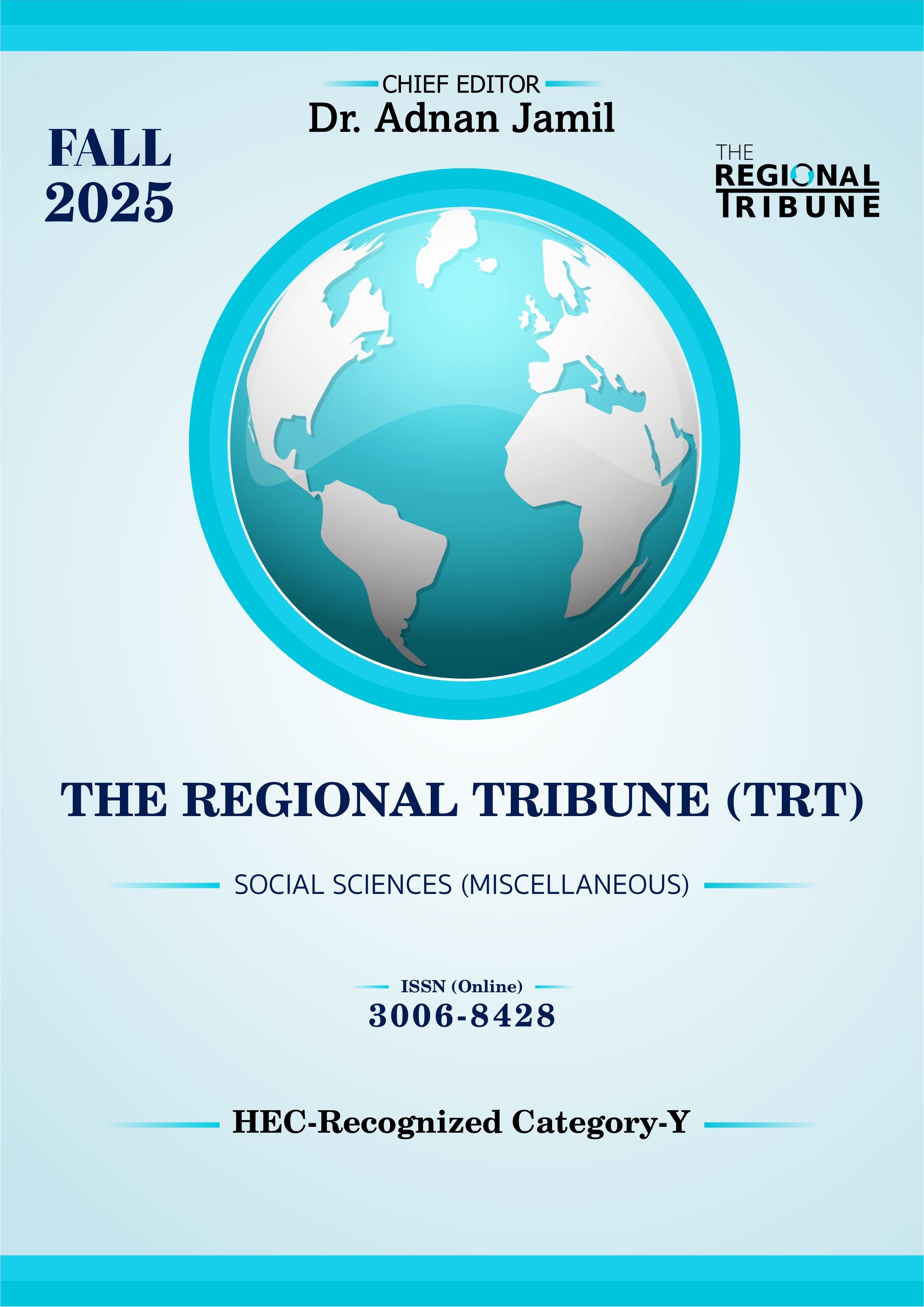A Comparative Analysis of Social Interaction Anxiety Among University and College Students of Gujrat, Pakistan
DOI:
https://doi.org/10.55737/trt/FL25.143Keywords:
Social Interaction Anxiety, Mental Health, University and College Comparison, Cultural ContextAbstract
Social interaction anxiety (SIA) is increasingly recognized as a significant challenge among students, influencing academic achievement, social adjustment, and psychological well-being. In contexts such as Pakistan, cultural expectations, family pressures, and limited access to mental health services can further intensify these experiences. The study aimed to examine the prevalence and severity of SIA among university and college students in Gujrat, Pakistan. A cross-sectional survey design was employed with 400 participants, including 200 university students and 200 college students. Using a convenient sampling technique, data were collected using the Social Interaction Anxiety Scale (SIAS) along with a demographic questionnaire. The majority of university students (71.3%) experience low social interaction anxiety, and 70.5% college students reported low levels of social interaction anxiety. The findings show that university students reported slightly higher anxiety (M = 31.27, SD = 12.18) than college students (M = 29.40, SD = 9.61), but the difference was not significant (t = 1.70, p = .090). In other words, social anxiety was found to be a shared struggle across both groups. By situating these results in the unique sociocultural landscape of Gujrat, this study contributes to a limited but growing body of literature on student mental health in Pakistan. It underscores the importance of addressing social anxiety to improve students' academic and personal development.
References
Abbas, A., & Shehzad, W. (2018). An exploration of interactive and interactional relationship (metadiscourse) in research discourses of Pakistan through corpus-based techniques. http://repository.pastic.gov.pk/jspui/handle/123456789/4267
Adeoye-Agboola, D. I., & Evans, H. (2015). The relationship between anxiety and academic performance of postgraduate international students in a British university: A cross-sectional quantitative design. Science Journal of Public Health, 3(3), 331–338. https://doi.org/10.11648/j.sjph.20150303.15
Ahmad, S. S., & Koncsol, S. W. (2022). Cultural factors influencing mental health stigma: Perceptions of Mental Illness (POMI) in Pakistani emerging adults. Religions, 13(5), 401. https://doi.org/10.3390/rel13050401
American Psychiatric Association. (2013). Diagnostic and statistical manual of mental disorders (5th ed.). Author. https://psycnet.apa.org/record/2013-14907-000
Archbell, K. A., & Coplan, R. J. (2021). Too Anxious to Talk: Social Anxiety, Academic Communication, and Students’ Experiences in Higher Education. Journal of Emotional and Behavioral Disorders, 30(4), 273. https://doi.org/10.1177/10634266211060079
Ayeras, S. R., Bumanlag, J., Guzman, B., Reyes, B. M., Ruiz, A. K., & Villarama, J. (2024). Too anxious to speak: Assessing the impact of social anxiety on high school students’ self-esteem, academic performance, and coping strategies. Journal of Interdisciplinary Perspectives, 2(7). https://doi.org/10.69569/jip.2024.0169
Beidel, D. C., & Turner, S. M. (2007). Shy children, phobic adults: Nature and treatment of social anxiety disorder. American Psychological Association. https://doi.org/10.1037/11533-000
Bella, T. T., & Omigbodun, O. O. (2009). Social phobia in Nigerian university students: Prevalence, correlates and comorbidity. Social Psychiatry and Psychiatric Epidemiology, 44(6), 458–463. https://doi.org/10.1007/s00127-008-0457-3
Bruch, M. A., Heimberg, R. G., Berger, P., & Collins, T. M. (1989). Social phobia and perceptions of early parental and personal characteristics. Anxiety Research, 2(1), 57–65. https://doi.org/10.1080/08917778908249326
Diana, E., Khaerani, F. A., Wijaya, M. Z., & Makhmudah, U. (2022). The Effectiveness of Group Counseling in Reducing Adolescent Social Anxiety Levels : A Systematic Literature Review. Social Humanities and Educational Studies (SHEs) Conference Series, 5(2), 474. https://doi.org/10.20961/shes.v5i2.59381
Heimberg, R. G., Hofmann, S. G., Liebowitz, M. R., Schneier, F. R., Smits, J. A., Stein, M. B., et al. (2014). Social anxiety disorder in DSM-5. Depression and Anxiety, 31(6), 472–479. https://doi.org/10.1002/da.22231
Heimberg, R. G., Mueller, G. P., Holt, C. S., Hope, D. A., & Liebowitz, M. R. (1992). Assessment of anxiety in social interaction and being observed by others: The Social Interaction Anxiety Scale and the Social Phobia Scale. Behavior Therapy, 23(1), 53–73. https://doi.org/10.1016/S0005-7894(05)80308-9
Husain, W., & Amir, G. (2020). Translation, adaptation and validation of Depression, Anxiety and Stress Scale in Urdu. Insights on the Depression and Anxiety, 4(1), 1–6. https://doi.org/10.29328/journal.ida.1001011
Islam, M. A., Barna, S. D., Raihan, H., Khan, M. N. A., & Hossain, M. T. (2020). Depression and anxiety among university students during the COVID-19 pandemic in Bangladesh: A web-based cross-sectional survey. PLoS ONE, 15(8), e0238162. https://doi.org/10.1371/journal.pone.0238162
Jefferies, P., & Ungar, M. (2020). Social anxiety in young people: A prevalence study in seven countries. PloS one, 15(9), e0239133. https://doi.org/10.1371/journal.pone.0239133
José, A., Roberto, R., & Raúl, R. (2023). Mediating effect of social interaction anxiety between emotional intelligence and life satisfaction in physical education students: Post-COVID-19 study. Frontiers in Psychology, 14, 1284664. https://doi.org/10.3389/fpsyg.2023.1284664
Kayani, S., Aajiz, N. M., Raza, K. K., Kayani, S., & Biasutti, M. (2022). Cognitive and interpersonal factors affecting social adjustment of university students in Pakistan. International Journal of Environmental Research and Public Health, 20(1), 655. https://doi.org/10.3390/ijerph20010655
Khuda, I. E., Aftab, A., Hasan, S., Ikram, S., Ahmad, S., Ateya, A. A., & Asim, M. (2024). Trends of social anxiety in university students of pakistan post-covid-19 lockdown: A healthcare analytics perspective. Information, 15(7), 373. https://doi.org/10.3390/info15070373
Lai, F., Wang, L., Zhang, J., Shan, S., Chen, J., & Tian, L. (2023). Relationship between social media use and social anxiety in college students: Mediation effect of communication capacity. International Journal of Environmental Research and Public Health, 20(4), 3657. https://doi.org/10.3390/ijerph20043657
Li, J., Xia, Y., Cheng, X., & Li, S. (2020). Fear of uncertainty makes you more anxious? Effect of intolerance of uncertainty on college students’ social anxiety: A moderated mediation model. Frontiers in Psychology, 11. https://doi.org/10.3389/fpsyg.2020.565107
Luan, Y. S., Zhan-Ling, G., Mi, L., Ying, L., Lan, B., & Tong, L. (2022). The experience among college students with social anxiety disorder in social situations: A qualitative study. Neuropsychiatric Disease and Treatment, 18, 1729–1737. https://doi.org/10.2147/NDT.S371402
Malik, S. (2015). Assessing level and causes of exam stress among university students in Pakistan. Mediterranean Journal of Social Sciences, 6(4 S1), 11. https://doi.org/10.5901/mjss.2015.v6n4s1p11
Marzouqi, A. A., Otim, M., Alblooshi, A., Marzooqi, S. A., Talal, M., & Wassim, F. (2022). State of emotional health disorders of undergraduate students in the United Arab Emirates: A cross-sectional survey. Psychology Research and Behavior Management, 15, 1423–1433. https://doi.org/10.2147/prbm.s365012
Mattick, R. P., & Clarke, J. C. (1998). Development and validation of measures of social phobia scrutiny fear and social anxiety. Behaviour Research and Therapy, 36(4), 455–470. https://doi.org/10.1016/S0005-7967(97)10031-6
Miers, A. C., Blöte, A. W., Bögels, S. M., & Westenberg, P. M. (2008). Interpretation bias and social anxiety in adolescents. Journal of Anxiety Disorders, 22(8), 1462–1471. https://doi.org/10.1016/j.janxdis.2008.02.010
Mineka, S., Watson, D., & Clark, L. A. (1998). Comorbidity of anxiety and unipolar mood disorders. Annual Review of Psychology, 49(1), 377–412. https://doi.org/10.1146/annurev.psych.49.1.377
Mou, Q., Zhuang, J., Wu, Q., Zhong, Y., Dai, Q., Cao, X., Gao, Y., Lu, Q., & Zhao, M. (2024). Social media addiction and academic engagement as serial mediators between social anxiety and academic performance among college students. BMC Psychology, 12(1). https://doi.org/10.1186/s40359-024-01635-7
Murad, O. S. (2020). Social anxiety in relation to self-esteem among university students in Jordan. International Education Studies, 13(2), 96–102. https://doi.org/10.5539/ies.v13n2p96
Nair, A. J. M., & Sreekumar, S. (2021). Social interaction anxiety and its influence on learning engagement of students during COVID-19. International Journal of Indian Psychology, 9(2), 1237–1243. https://doi.org/10.25215/0902.130
National Institute of Mental Health. (2022). Social anxiety disorder: More than just shyness. https://www.nimh.nih.gov/health/publications/social-anxiety-disorder-more-than-just-shyness
Ollendick, T. H., & Hirshfeld-Becker, D. R. (2002). The developmental psychopathology of social anxiety disorder. Biological Psychiatry, 51(1), 44–58. https://doi.org/10.1016/S0006-3223(01)01305-1
Ouyang, X., Cai, Y., & Tu, D. (2020). Psychometric Properties of the Short Forms of the Social Interaction Anxiety Scale and the Social Phobia Scale in a Chinese College Sample. Frontiers in Psychology, 11. https://doi.org/10.3389/fpsyg.2020.02214
Peters, L. (2000). Discriminant validity of the Social Phobia and Anxiety Inventory (SPAI), the Social Phobia Scale (SPS) and the Social Interaction Anxiety Scale (SIAS). Behaviour Research and Therapy, 38(9), 943–950. https://doi.org/10.1016/s0005-7967(99)00131-x
Pini, S., Dell’Osso, L., Abelli, M., Carlini, M., Mengali, F., Carpita, B., Macchi, E., Gorrasi, F., Tognetti, R., & Massimetti, G. (2014). Dimensional assessment of DSM-5 social anxiety symptoms among university students and its relationship with functional impairment. Neuropsychiatric Disease and Treatment, 10, 1325–1332. https://doi.org/10.2147/NDT.S59348
Reta, Y., Ayalew, M., Yeneabat, T., & Bedaso, A. (2020). Social anxiety disorder among undergraduate students of Hawassa University, College of Medicine and Health Sciences, Ethiopia. Neuropsychiatric Disease and Treatment, 16, 571–577. https://doi.org/10.2147/NDT.S235416
Rukhos, J., Jabar, A., Karim, S., & Hassan, A. (2017). Prevalence of social anxiety in students of College of Education – University of Garmian. Researchers World: Journal of Arts, Science and Commerce, 8(3), 78–84. https://doi.org/10.18843/RWJASC%2FV8I3%281%29%2F12
Sanders, D., & Wills, F. (2002). Counselling for anxiety problems. SAGE Publications Ltd, https://doi.org/10.4135/9781446219737
Schneier, F. R., Blanco, C., Antia, S. X., & Liebowitz, M. R. (2002). The social anxiety spectrum. Psychiatric Clinics of North America, 25(4), 757–774. https://doi.org/10.1016/S0193-953X(02)00020-1
Sifat, M., Huq, M., Baig, M., Tasnim, N., & Green, K. M. (2023). An examination of barriers to accessing mental health care, and their association with depression, stress, suicidal ideation, and wellness in a Bangladeshi university student sample. International Journal of Environmental Research and Public Health, 20(2), 904. https://doi.org/10.3390/ijerph20020904
Stein, M. B., & Stein, D. J. (2008). Social anxiety disorder. The Lancet, 371(9618), 1115–1125. https://doi.org/10.1016/S0140-6736(08)60488-2
Vera, D. (2019). Comprehending support decisions of undergraduates who experienced anxiety and depression (Publication No. 8368) [Doctoral dissertation]. Walden University. Walden Dissertations and Doctoral Studies. https://scholarworks.waldenu.edu/dissertations/8368
Vitasari, P., Wahab, M. N. A., Othman, A., & Awang, M. G. (2010). A research for identifying study anxiety sources among university students. International Education Studies, 3(2), 189–196. https://doi.org/10.5539/ies.v3n2p189
Xu, L., & Li, L. (2024). Upward social comparison and social anxiety among Chinese college students: A chain-mediation model of relative deprivation and rumination. Frontiers in Psychology, 15, 1430539. https://doi.org/10.3389/fpsyg.2024.1430539
Zhang, Y., Shan, Z., Wu, Y., & Fu, Y. (2022). Research on the formation and control of college students’ social anxiety in virtual community situation. Frontiers in Business, Economics and Management, 6(1), 26–36. https://doi.org/10.54097/fbem.v6i1.2255
Downloads
Published
Issue
Section
License
Copyright (c) 2025 Dr. Noreena Kausar, Ume Habiba, Shumaila Ilyas, Iram Naz

This work is licensed under a Creative Commons Attribution-NonCommercial 4.0 International License.



